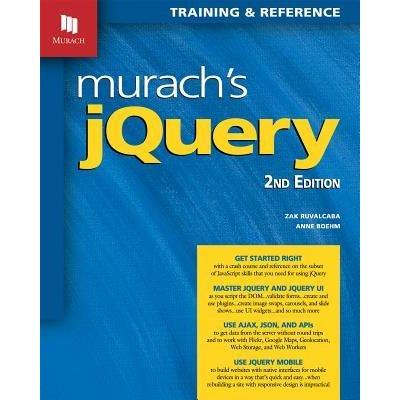Новости
|
 Автор: VnRuEn | Автор: VnRuEn |  Дата: 14 августа 2017| Дата: 14 августа 2017|  Просмотров: 0 Просмотров: 0
|
В разделе: - [Информация] |
|
 Murach's jQuery (2nd Edition) English | Size: 170.11 MB Category: e-Books This book works especially well for people with some programming experience. That includes: web developers who have done some javascript programming but are new to jQuery web developers who do server-side programming on platforms like ASP.NET, JSP, or PHP and now want to master client-side programming too web developers who have used jQuery for special-purpose applications, but don't feel comfortable with it web developers who have already read 3 or 4 jQuery books but still aren't sure how to use jQuery in real-world applications If you have no programming experience at all, this book can still work for you because section 1 presents the javascript you need to know. But a better alternative for most people is to start with Murach's javascript and then go on this jQuery book after you're comfortable with javascript. This makes complete sense for those who want to master both javascript and jQuery. Section 1: The least you need to know about javascript to get the most from jQuery To use jQuery, you need to know how to use at least a subset of javascript. That's why section 1 of this book presents a crash course in the javascript skills that you need for using jQuery. This section also serves as a javascript reference when you can't remember how some of the javascript code in a jQuery example or application works. This section works best if you have some programming experience, even if that experience isn't with javascript. The more experience you have, the faster you can move through this section. Note, however, that this section also works for people with no programming experience. It just takes longer to go through the material. For some beginners, though, a better alternative is to start with Murach's javascript and then go on to this jQuery book. In the long run, you're probably going to want to master both. Section 2: The core jQuery skills for every web developer In this section, you'll learn how to use jQuery to create javascript applications like image swaps, collapsible panels, slide shows, carousels, user-friendly formsand morewith far less coding than you'd have to do in native javascript. To begin, chapter 5 presents the jQuery selectors, methods, and event methods that you'll use most often. Then, the next four chapters build on that base as they focus on how to use effects and animations, how to use the many plugins that are available for jQuery, how to create your own plugins, how to work with forms and controls, and how to manipulate and traverse the DOM. When you complete this section, you can go on to any of the three sections that follow. Section 3: Enhance your web pages by using jQuery UI Besides the core jQuery library, jQuery provides the jQuery UI (User Interface) library. This library helps you build features that your site visitors may appreciate, all with just a few lines of code. So this section shows you how to use jQuery UI to create widgets like tabs, accordions, and datepickersinteractions like draggable, droppable, and sortableand effects like color and class transitions. Section 4: Speed up response times and add content feeds with Ajax and JSON Ajax and JSON can be used to get data from a server and add it to a web page without reloading the entire page, and that can significantly improve response times for users (if you've ever scrolled around a Google Map, you've seen this in action). But to be honest, the coding can be mind-bending. Fortunately, jQuery provides methods that make it far more manageable. So in this section, you'll learn how to use jQuery with Ajax and JSON to deliver data to your websites. First, you'll learn the basics. Then, you'll learn how to use these skills with APIs like the ones for Flickr and Google Maps and thus add popular content to your pages. Last, you'll learn how to use HTML5 APIs like Web Storage and Web Workers with Ajax and JSON. Section 5: Mobile websites made easier with jQuery Mobile This section shows you how to use the jQuery Mobile library to develop web pages for mobile devices with the look-and-feel of native applications. For large, established websites, this is often a practical alternative to responsive web design. In fact, there's no better way to build separate websites for mobile devices. |
||
|
|
||

 Murach's jQuery (2nd Edition)
Murach's jQuery (2nd Edition) 